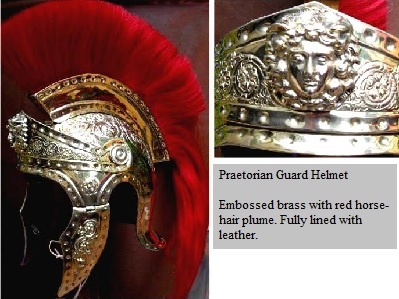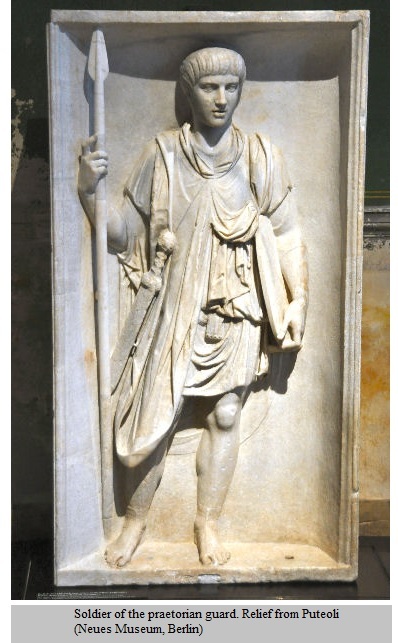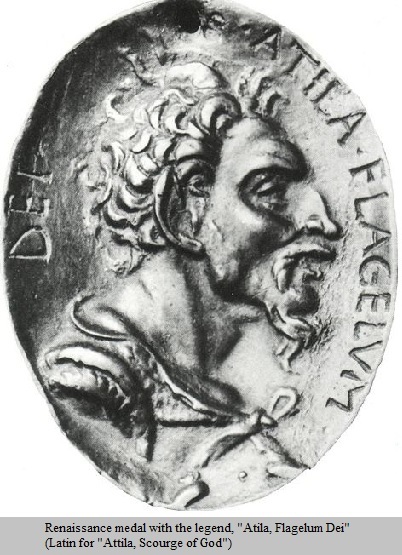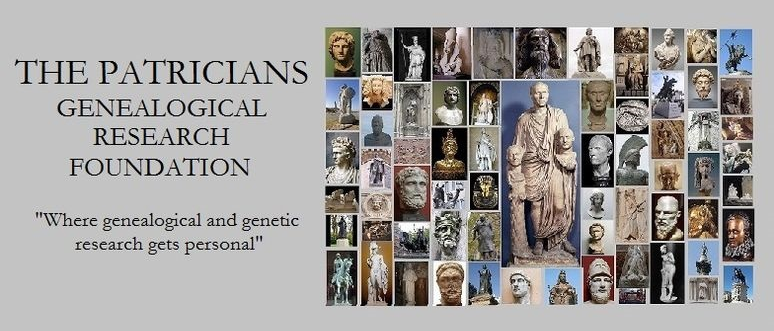












“The discomfiture of the mighty attempt of Attila to found a new
anti-Christian dynasty upon the wreck of the temporal power of
Rome, at the end of the term of twelve hundred years, to which
its duration had been limited by the forebodings of the
heathen.”—Hebert
Tonantius Ferreolus served as one of the last Gallo-Roman praetorian prefects at the time Attila and his Hunnic army invaded Gaul. Before the invasion, he was instrumental in allying independent Gallic barbarian armies, including those led by Merovech Meroving (412 – 458; grandfather of Clovis I Meroving (466 – 511) 1st King of Franks, 1st Christian Ruler of Gaul) and Theodoric I (393 – 451) King of the Visigoths, under the banner of Roman General Flavius Aetius (391 – 454) for the successful defense of the Roman territory at the Battle of Châlons in 451.
Atilla’s decisive defeat at the Battle of Châlons marks a major turning point in human history since his victory might have spelled the end of Western Civilization. Accordingly, it’s ranked as the 6th most decisive military battle ever fought in Sir Edward Shepherd Creasy’s book, entitled The Fifteen Decisive Battles of the World: from Marathon to Waterloo (1851). The following excerpt opines as to its relative significance:
“Attila’s attacks on the Western empire were soon renewed; but never with such peril to the civilized world as had menaced it before his defeat at Chalons. And on his death, two years after that battle, the vast empire which his genius had founded was soon dissevered by the successful revolts of the subject nations. The name of the Huns ceased for some centuries to inspire terror in Western Europe, and their ascendency passed away with the life of the great king by whom it had been so fearfully augmented.”
The maternal grandson of Emperor Avitus (397 – 457), Tonantius descended from a family of Roman nobility that flourished in recorded Roman history since the first century A.D. His mother was a clarissima femina and daughter of Flavius Afranius Syagrius, Consul in 382. Individual members of the lineage regularly served as senators and praetorian prefects. For instance, Flavius Eparchius (295 – 340) was Augustus Prefect of Egypt twice, initially between 335 and 337, and subsequently between 338 and 340 during Constantine the Great’s ruler of the Roman Empire.
Before the ascendency of Constantine the Great I (279 – 337) First Christian Emperor of Rome, Saint as the Emperor of Rome, Praetorian Prefects commanded the Praetorian Guard. During his reign, he began the appointing Prefects to govern one of the four Roman prefectures that comprised the Roman Empire after he divided it into two parts – the Western Roman Empire and the Eastern Roman Empire. In that capacity, the prefect held the highest administrative position within the prefecture itself, wielding about the same amount of political responsibility and power as a modern U.S. state governor.
Just before his ascendency as Emperor, Titus Caesar Vespasianus (39 – 81) served as his father’s Praetorian Prefect under the ancient regime whereby Praetorian Guards were responsible for the emperor’s security. Sometimes, however, the Praetorian Prefect performed exactly the opposite function in staging coups d’état. This was likely one of Constantine’s primary motives in stripping the “Imperial guard” function from the office.
The defeat of Flavius Afranius Syagrius, Tonantius’s maternal grandfather and last Roman Prefect of Gaul, at the Battle of Soissons (486) marked the official end of Roman Gaul. Though Clovis I Meroving (466 – 511) later had him assassinated following his capture, he reinstated the Syagrius kingdom to Syagrius’ heirs.
The first historical mention of the Syagrius’ bloodline, known as gens Afrania, comes during the second century BC with the advent of Gaius Afranius Stellio as Roman praetor of Egypt in 185 BC. The family tree goes back more ancient times to Greece, the most notable regions in and around Sparta and Troy (today’s southwestern Turkey).
Tonantius was the agnatic forebear of Saint Arnulf of Metz (582 – 640) Bishop of Metz, Patron Saint of Brewers, and a direct descendant of Marcus Aurelius Annius Verus (121 – 180) ) Emperor of Rome.
Related blog articles:
The Fifteen Decisive Battles of the World (1851), Sir Edward Shepherd Creasy
Gaius Julius Caesar (100 – 44 BC) General, Consul, 1st Dictator of Rome
Hugh Capet (939 – 996) 1st “King of the Franks”
Charlemagne (742 – 814) King of Franks and Lombards, Emperor of the Romans
Clovis I Meroving (466 – 511) 1st King of Franks, 1st Christian Ruler of Gaul
Henry II Plantagenet (1133 – 1189) 1st Plantagenet King of England and Ireland
.
Tonantius II Ferreolus, praefecti praetorio Galliarum
Birth by 418 in Rome, Roma, Lazio, Italy
Death 476 in Narbonne, Aude, Languedoc-Roussillon, France
Ancestry.com citation/Lineages
42nd great-granduncle CAROLMAN-PERRACY-VEXIN-CHAUMONT-SINCLAIR-PAINE-TRIPP-OUTWATER-COLLINS
48th great-grandfather PLANTAGENET-FITZALAN-MOWBRAY-HOWARD-WOOD-COLLINS
BIBLIOGRAPHY
Battles of the Ancient World 1285 BC – AD 451: From Kadesh to Catalaunian Field
The Patricians, A Genealogical Study – Ebook Editions US$5.95


Steven Wood Collins (1952 – ) Antiquarian, Genealogist, Novelist


184 replies on “Tonantius Ferreolus (418 – 476) Praetorian Prefect of Gaul”
[…] Tonantius Ferreolus (418 – 476) Roman Praetorian Prefect of Gaul 6GGF […]
LikeLike
[…] Tonantius Ferreolus (418 – 476) Roman Praetorian Prefect of Gaul 6GGF […]
LikeLike
[…] Tonantius Ferreolus (418 – 476) Roman Praetorian Prefect of Gaul 6GGF […]
LikeLike
[…] Tonantius Ferreolus (418 – 476) Roman Praetorian Prefect of Gaul 6GGF […]
LikeLike
[…] Tonantius Ferreolus (418 – 476) Roman Praetorian Prefect of Gaul 6GGF […]
LikeLike
[…] Tonantius Ferreolus (418 – 476) Roman Praetorian Prefect of Gaul 6GGF […]
LikeLike
[…] Tonantius Ferreolus (418 – 476) Roman Praetorian Prefect of Gaul 6GGF […]
LikeLike
[…] Tonantius Ferreolus (418 – 476) Roman Praetorian Prefect of Gaul 6GGF […]
LikeLike
[…] Tonantius Ferreolus (418 – 476) Roman Praetorian Prefect of Gaul 6GGF […]
LikeLike
[…] Tonantius Ferreolus (418 – 476) Roman Praetorian Prefect of Gaul 6GGF […]
LikeLike
[…] Tonantius Ferreolus (418 – 476) Roman Praetorian Prefect of Gaul 6GGF […]
LikeLike
[…] Tonantius Ferreolus (418 – 476) Roman Praetorian Prefect of Gaul 6GGF […]
LikeLike
[…] Tonantius Ferreolus (418 – 476) Roman Praetorian Prefect of Gaul 6GGF […]
LikeLike
[…] Tonantius Ferreolus (418 – 476) Roman Praetorian Prefect of Gaul 6GGF […]
LikeLike
[…] Tonantius Ferreolus (418 – 476) Roman Praetorian Prefect of Gaul 6GGF […]
LikeLike
[…] Tonantius Ferreolus (418 – 476) Roman Praetorian Prefect of Gaul 6GGF […]
LikeLike
[…] Tonantius Ferreolus (418 – 476) Roman Praetorian Prefect of Gaul 6GGF […]
LikeLike
[…] Tonantius Ferreolus (418 – 476) Roman Praetorian Prefect of Gaul 6GGF […]
LikeLike
[…] Tonantius Ferreolus (418 – 476) Roman Praetorian Prefect of Gaul 6GGF […]
LikeLike
[…] Tonantius Ferreolus (418 – 476) Roman Praetorian Prefect of Gaul 6GGF […]
LikeLike
[…] Tonantius Ferreolus (418 – 476) Roman Praetorian Prefect of Gaul 6GGF […]
LikeLike
[…] Tonantius Ferreolus (418 – 476) Roman Praetorian Prefect of Gaul 6GGF […]
LikeLike
[…] Tonantius Ferreolus (418 – 476) Roman Praetorian Prefect of Gaul 6GGF […]
LikeLike
[…] Tonantius Ferreolus (418 – 476) Roman Praetorian Prefect of Gaul 6GGF […]
LikeLike
[…] Tonantius Ferreolus (418 – 476) Roman Praetorian Prefect of Gaul 6GGF […]
LikeLike
[…] Tonantius Ferreolus (418 – 476) Roman Praetorian Prefect of Gaul 6GGF […]
LikeLike
[…] Tonantius Ferreolus (418 – 476) Roman Praetorian Prefect of Gaul 6GGF […]
LikeLike
[…] Tonantius Ferreolus (418 – 476) Roman Praetorian Prefect of Gaul 6GGF […]
LikeLike
[…] Tonantius Ferreolus (418 – 476) Roman Praetorian Prefect of Gaul 6GGF […]
LikeLike
[…] Tonantius Ferreolus (418 – 476) Roman Praetorian Prefect of Gaul 6GGF […]
LikeLike
[…] Tonantius Ferreolus (418 – 476) Roman Praetorian Prefect of Gaul 6GGF […]
LikeLike
[…] Tonantius Ferreolus (418 – 476) Roman Praetorian Prefect of Gaul 6GGF […]
LikeLike
[…] Tonantius Ferreolus (418 – 476) Roman Praetorian Prefect of Gaul 6GGF […]
LikeLike
[…] Tonantius Ferreolus (418 – 476) Roman Praetorian Prefect of Gaul 6GGF […]
LikeLike
[…] Tonantius Ferreolus (418 – 476) Roman Praetorian Prefect of Gaul 6GGF […]
LikeLike
[…] Tonantius Ferreolus (418 – 476) Roman Praetorian Prefect of Gaul 6GGF […]
LikeLike
[…] Tonantius Ferreolus (418 – 476) Roman Praetorian Prefect of Gaul 6GGF […]
LikeLike
[…] Tonantius Ferreolus (418 – 476) Roman Praetorian Prefect of Gaul 6GGF […]
LikeLike
[…] Tonantius Ferreolus (418 – 476) Roman Praetorian Prefect of Gaul 6GGF […]
LikeLike
[…] Tonantius Ferreolus (418 – 476) Roman Praetorian Prefect of Gaul 6GGF […]
LikeLike
[…] Tonantius Ferreolus (418 – 476) Roman Praetorian Prefect of Gaul 6GGF […]
LikeLike
[…] Tonantius Ferreolus (418 – 476) Roman Praetorian Prefect of Gaul 6GGF […]
LikeLike
[…] Tonantius Ferreolus (418 – 476) Roman Praetorian Prefect of Gaul 6GGF […]
LikeLike
[…] agnatic descendant of Tonantius Ferreolus (418 – 476) Roman Praetorian Prefect of Gaul […]
LikeLike
[…] Tonantius Ferreolus (418 – 476) Roman Praetorian Prefect of Gaul 6GGF […]
LikeLike
[…] Tonantius Ferreolus (418 – 476) Roman Praetorian Prefect of Gaul 6GGF […]
LikeLike
[…] Tonantius Ferreolus (418 – 476) Roman Praetorian Prefect of Gaul 6GGF […]
LikeLike
[…] Tonantius Ferreolus (418 – 476) Roman Praetorian Prefect of Gaul 6GGF […]
LikeLike
[…] Tonantius Ferreolus (418 – 476) Roman Praetorian Prefect of Gaul 6GGF […]
LikeLike
[…] Tonantius Ferreolus (418 – 476) Roman Praetorian Prefect of Gaul 6GGF […]
LikeLike
[…] Tonantius Ferreolus (418 – 476) Roman Praetorian Prefect of Gaul 6GGF […]
LikeLike
[…] Tonantius Ferreolus (418 – 476) Roman Praetorian Prefect of Gaul 6GGF […]
LikeLike
[…] Tonantius Ferreolus (418 – 476) Roman Praetorian Prefect of Gaul 6GGF […]
LikeLike
[…] Tonantius Ferreolus (418 – 476) Roman Praetorian Prefect of Gaul 6GGF […]
LikeLike
[…] Tonantius Ferreolus (418 – 476) Roman Praetorian Prefect of Gaul 6GGF […]
LikeLike
[…] Tonantius Ferreolus (418 – 476) Roman Praetorian Prefect of Gaul 6GGF […]
LikeLike
[…] Tonantius Ferreolus (418 – 476) Roman Praetorian Prefect of Gaul 6GGF […]
LikeLike
[…] Tonantius Ferreolus (418 – 476) Roman Praetorian Prefect of Gaul 6GGF […]
LikeLike
[…] Tonantius Ferreolus (418 – 476) Roman Praetorian Prefect of Gaul 6GGF […]
LikeLike
[…] descendant of Tonantius Ferreolus (418 – 476) Roman Praetorian Prefect of Gaul and Henry de St Clair – Sinclair, 7th Earl of Rosslyn (1255 – […]
LikeLike
[…] Tonantius Ferreolus (418 – 476) Roman Praetorian Prefect of Gaul 6GGF […]
LikeLike
[…] Tonantius Ferreolus (418 – 476) Roman Praetorian Prefect of Gaul 6GGF […]
LikeLike
[…] Tonantius Ferreolus (418 – 476) Roman Praetorian Prefect of Gaul 6GGF […]
LikeLike
[…] Tonantius Ferreolus (418 – 476) Roman Praetorian Prefect of Gaul 6GGF […]
LikeLike
[…] Tonantius Ferreolus (418 – 476) Roman Praetorian Prefect of Gaul 6GGF […]
LikeLike
[…] Tonantius Ferreolus (418 – 476) Roman Praetorian Prefect of Gaul 6GGF […]
LikeLike
[…] Tonantius Ferreolus (418 – 476) Roman Praetorian Prefect of Gaul 6GGF […]
LikeLike
[…] Tonantius Ferreolus (418 – 476) Roman Praetorian Prefect of Gaul 6GGF […]
LikeLike
[…] Tonantius Ferreolus (418 – 476) Roman Praetorian Prefect of Gaul 6GGF […]
LikeLike
[…] Tonantius Ferreolus (418 – 476) Roman Praetorian Prefect of Gaul 6GGF […]
LikeLike
[…] Tonantius Ferreolus (418 – 476) Roman Praetorian Prefect of Gaul 6GGF […]
LikeLike
[…] Tonantius Ferreolus (418 – 476) Roman Praetorian Prefect of Gaul 6GGF […]
LikeLike
[…] Tonantius Ferreolus (418 – 476) Roman Praetorian Prefect of Gaul 6GGF […]
LikeLike
[…] Tonantius Ferreolus (418 – 476) Roman Praetorian Prefect of Gaul 6GGF […]
LikeLike
[…] Tonantius Ferreolus (418 – 476) Roman Praetorian Prefect of Gaul 6GGF […]
LikeLike
[…] Tonantius Ferreolus (418 – 476) Roman Praetorian Prefect of Gaul 6GGF […]
LikeLike
[…] Tonantius Ferreolus (418 – 476) Roman Praetorian Prefect of Gaul 6GGF […]
LikeLike
[…] Tonantius Ferreolus (418 – 476) Roman Praetorian Prefect of Gaul 6GGF […]
LikeLike
[…] Tonantius Ferreolus (418 – 476) Roman Praetorian Prefect of Gaul 6GGF […]
LikeLike
[…] Tonantius Ferreolus (418 – 476) Roman Praetorian Prefect of Gaul 6GGF […]
LikeLike
[…] Tonantius Ferreolus (418 – 476) Roman Praetorian Prefect of Gaul 6GGF […]
LikeLike
[…] Tonantius Ferreolus (418 – 476) Roman Praetorian Prefect of Gaul 6GGF […]
LikeLike
[…] Tonantius Ferreolus (418 – 476) Roman Praetorian Prefect of Gaul 6GGF […]
LikeLike
[…] Tonantius Ferreolus (418 – 476) Roman Praetorian Prefect of Gaul 6GGF […]
LikeLike
[…] Tonantius Ferreolus (418 – 476) Roman Praetorian Prefect of Gaul 6GGF […]
LikeLike
[…] Tonantius Ferreolus (418 – 476) Roman Praetorian Prefect of Gaul 6GGF […]
LikeLike
[…] Tonantius Ferreolus (418 – 476) Roman Praetorian Prefect of Gaul 6GGF […]
LikeLike
[…] Tonantius Ferreolus (418 – 476) Roman Praetorian Prefect of Gaul 6GGF […]
LikeLike
[…] Tonantius Ferreolus (418 – 476) Roman Praetorian Prefect of Gaul 6GGF […]
LikeLike
[…] Tonantius Ferreolus (418 – 476) Roman Praetorian Prefect of Gaul 6GGF […]
LikeLike
[…] Tonantius Ferreolus (418 – 476) Roman Praetorian Prefect of Gaul 6GGF […]
LikeLike
[…] Tonantius Ferreolus (418 – 476) Roman Praetorian Prefect of Gaul 6GGF […]
LikeLike
[…] Tonantius Ferreolus (418 – 476) Roman Praetorian Prefect of Gaul 6GGF […]
LikeLike
[…] Tonantius Ferreolus (418 – 476) Roman Praetorian Prefect of Gaul 6GGF […]
LikeLike
[…] Tonantius Ferreolus (418 – 476) Roman Praetorian Prefect of Gaul 6GGF […]
LikeLike
[…] Tonantius Ferreolus (418 – 476) Roman Praetorian Prefect of Gaul 6GGF […]
LikeLike
[…] Tonantius Ferreolus (418 – 476) Roman Praetorian Prefect of Gaul 6GGF […]
LikeLike
[…] Tonantius Ferreolus (418 – 476) Roman Praetorian Prefect of Gaul 6GGF […]
LikeLike
[…] Tonantius Ferreolus (418 – 476) Roman Praetorian Prefect of Gaul 6GGF […]
LikeLike
[…] agnatic descendant of Tonantius Ferreolus (418 – 476) Roman Praetorian Prefect of Gaul […]
LikeLike
[…] Tonantius Ferreolus (418 – 476) Roman Praetorian Prefect of Gaul 6GGF […]
LikeLike
[…] Tonantius Ferreolus (418 – 476) Roman Praetorian Prefect of Gaul 6GGF […]
LikeLike
[…] Tonantius Ferreolus (418 – 476) Roman Praetorian Prefect of Gaul 6GGF […]
LikeLike
[…] Tonantius Ferreolus (418 – 476) Roman Praetorian Prefect of Gaul 6GGF […]
LikeLike
[…] Tonantius Ferreolus (418 – 476) Roman Praetorian Prefect of Gaul 6GGF […]
LikeLike
[…] Tonantius Ferreolus (418 – 476) Roman Praetorian Prefect of Gaul 6GGF […]
LikeLike
[…] Tonantius Ferreolus (418 – 476) Roman Praetorian Prefect of Gaul 6GGF […]
LikeLike
[…] Tonantius Ferreolus (418 – 476) Roman Praetorian Prefect of Gaul 6GGF […]
LikeLike
[…] Tonantius Ferreolus (418 – 476) Roman Praetorian Prefect of Gaul 6GGF […]
LikeLike
[…] Tonantius Ferreolus (418 – 476) Roman Praetorian Prefect of Gaul 6GGF […]
LikeLike
[…] Tonantius Ferreolus (418 – 476) Roman Praetorian Prefect of Gaul […]
LikeLike
[…] Tonantius Ferreolus (418 – 476) Roman Praetorian Prefect of Gaul 6GGF […]
LikeLike
[…] Tonantius Ferreolus (418 – 476) Roman Praetorian Prefect of Gaul 6GGF […]
LikeLike
[…] Tonantius Ferreolus (418 – 476) Roman Praetorian Prefect of Gaul 6GGF […]
LikeLike
[…] Tonantius Ferreolus (418 – 476) Roman Praetorian Prefect of Gaul 6GGF […]
LikeLike
[…] Tonantius Ferreolus (418 – 476) Roman Praetorian Prefect of Gaul 6GGF […]
LikeLike
[…] Tonantius Ferreolus (418 – 476) Roman Praetorian Prefect of Gaul 6GGF […]
LikeLike
[…] Tonantius Ferreolus (418 – 476) Roman Praetorian Prefect of Gaul 6GGF […]
LikeLike
[…] Tonantius Ferreolus (418 – 476) Roman Praetorian Prefect of Gaul 6GGF […]
LikeLike
[…] Tonantius Ferreolus (418 – 476) Roman Praetorian Prefect of Gaul 6GGF […]
LikeLike
[…] Tonantius Ferreolus (418 – 476) Roman Praetorian Prefect of Gaul 6GGF […]
LikeLike
[…] Tonantius Ferreolus (418 – 476) Roman Praetorian Prefect of Gaul 6GGF […]
LikeLike
[…] Tonantius Ferreolus (418 – 476) Roman Praetorian Prefect of Gaul 6GGF […]
LikeLike
[…] Tonantius Ferreolus (418 – 476) Roman Praetorian Prefect of Gaul 5GGF […]
LikeLike
[…] Tonantius Ferreolus (418 – 476) Roman Praetorian Prefect of Gaul 5GGF […]
LikeLike
[…] Tonantius Ferreolus (418 – 476) Roman Praetorian Prefect of Gaul […]
LikeLike
[…] Tonantius Ferreolus (418 – 476) Roman Praetorian Prefect of Gaul […]
LikeLike
[…] Tonantius Ferreolus (418 – 476) Roman Praetorian Prefect of Gaul […]
LikeLike
[…] Tonantius Ferreolus (418 – 476) Roman Praetorian Prefect of Gaul 5GGF […]
LikeLike
[…] Tonantius Ferreolus (418 – 476) Roman Praetorian Prefect of Gaul 5GGF […]
LikeLike
[…] Tonantius Ferreolus (418 – 476) Roman Praetorian Prefect of Gaul 5GGF […]
LikeLike
[…] agnatic descendant of Tonantius Ferreolus (418 – 476) Roman Praetorian Prefect of Gaul 5 […]
LikeLike
[…] Tonantius Ferreolus (418 – 476) Roman Praetorian Prefect of Gaul 5GGF […]
LikeLike
[…] Tonantius Ferreolus (418 – 476) Roman Praetorian Prefect of Gaul 5GGF […]
LikeLike
[…] Tonantius Ferreolus (418 – 476) Roman Praetorian Prefect of Gaul 5GGF […]
LikeLike
[…] Tonantius Ferreolus (418 – 476) Roman Praetorian Prefect of Gaul 5GGF […]
LikeLike
[…] Tonantius Ferreolus (418 – 476) Roman Praetorian Prefect of Gaul 5GGF […]
LikeLike
[…] Tonantius Ferreolus (418 – 476) Roman Praetorian Prefect of Gaul 5GGF […]
LikeLike
[…] Tonantius Ferreolus (418 – 476) Roman Praetorian Prefect of Gaul 5GGF […]
LikeLike
[…] Tonantius Ferreolus (418 – 476) Roman Praetorian Prefect of Gaul 5GGF […]
LikeLike
[…] Tonantius Ferreolus (418 – 476) Roman Praetorian Prefect of Gaul 5GGF […]
LikeLike
[…] Tonantius Ferreolus (418 – 476) Roman Praetorian Prefect of Gaul 5GGF […]
LikeLike
[…] Tonantius Ferreolus (418 – 476) Roman Praetorian Prefect of Gaul […]
LikeLike
[…] Tonantius Ferreolus (418 – 476) Roman Praetorian Prefect of Gaul 5GGF […]
LikeLike
[…] Tonantius Ferreolus (418 – 476) Roman Praetorian Prefect of Gaul […]
LikeLike
[…] Tonantius Ferreolus (418 – 476) Roman Praetorian Prefect of Gaul 5GGF […]
LikeLike
[…] Tonantius Ferreolus (418 – 476) Roman Praetorian Prefect of Gaul 5GGF […]
LikeLike
[…] Tonantius Ferreolus (418 – 476) Roman Praetorian Prefect of Gaul 5GGF […]
LikeLike
[…] Tonantius Ferreolus (418 – 476) Roman Praetorian Prefect of Gaul 5GGF […]
LikeLike
[…] Tonantius Ferreolus (418 – 476) Roman Praetorian Prefect of Gaul 5GGF […]
LikeLike
[…] Tonantius Ferreolus (418 – 476) Roman Praetorian Prefect of Gaul 5GGF […]
LikeLike
[…] Tonantius Ferreolus (418 – 476) Roman Praetorian Prefect of Gaul 5GGF […]
LikeLike
[…] Tonantius Ferreolus (418 – 476) Roman Praetorian Prefect of Gaul 5GGF […]
LikeLike
[…] Tonantius Ferreolus (418 – 476) Roman Praetorian Prefect of Gaul 5GGF […]
LikeLike
[…] Tonantius Ferreolus (418 – 476) Roman Praetorian Prefect of Gaul 5GGF agnatic […]
LikeLike
[…] Tonantius Ferreolus (418 – 476) Roman Praetorian Prefect of Gaul 5GGF agnatic […]
LikeLike
[…] Tonantius Ferreolus (418 – 476) Roman Praetorian Prefect of Gaul 5GGF agnatic […]
LikeLike
[…] Tonantius Ferreolus (418 – 476) Roman Praetorian Prefect of Gaul 5GGF agnatic […]
LikeLike
[…] Tonantius Ferreolus (418 – 476) Roman Praetorian Prefect of Gaul 5GGF agnatic […]
LikeLike
[…] Tonantius Ferreolus (418 – 476) Roman Praetorian Prefect of Gaul 5GGF agnatic […]
LikeLike
[…] Tonantius Ferreolus (418 – 476) Roman Praetorian Prefect of Gaul 5GGF agnatic […]
LikeLike
[…] Tonantius Ferreolus (418 – 476) Roman Praetorian Prefect of Gaul 5GGF agnatic […]
LikeLike
[…] Tonantius Ferreolus (418 – 476) Roman Praetorian Prefect of Gaul […]
LikeLike
[…] Tonantius Ferreolus (418 – 476) Roman Praetorian Prefect of Gaul 5GGF D […]
LikeLike
[…] Tonantius Ferreolus (418 – 476) Praetorian Prefect of Gaul […]
LikeLike
[…] maternal grandfather of Tonantius Ferreolus (418 – 476) Roman Praetorian Prefect of Gaul […]
LikeLike
[…] Tonantius Ferreolus (418 – 476) Roman Praetorian Prefect of Gaul […]
LikeLike
[…] Tonantius Ferreolus (418 – 476) Roman Praetorian Prefect of Gaul […]
LikeLike
[…] Tonantius Ferreolus (418 – 476) Roman Praetorian Prefect of Gaul […]
LikeLike
[…] Tonantius Ferreolus (418 – 476) Roman Praetorian Prefect of Gaul […]
LikeLike
[…] Tonantius Ferreolus (418 – 476) Roman Praetorian Prefect of Gaul […]
LikeLike
[…] Tonantius Ferreolus (418 – 476) Roman Praetorian Prefect of Gaul […]
LikeLike
[…] Tonantius Ferreolus (418 – 476) Roman Praetorian Prefect of Gaul […]
LikeLike
[…] powers. Thereafter they served as administrators, mainly governing Roman prefects, such as Gaul. Tonantius Ferreolus (418 – 476) served as one of the last Gallo-Roman praetorian prefects at the time Attila (406 […]
LikeLike
[…] Tonantius Ferreolus (418 – 476) Roman Praetorian Prefect of Gaul […]
LikeLike
[…] Tonantius Ferreolus (418 – 476) Roman Praetorian Prefect of Gaul […]
LikeLike
[…] Tonantius Ferreolus (418 – 476) Roman Praetorian Prefect of Gaul […]
LikeLike
[…] Tonantius Ferreolus (418 – 476) Roman Praetorian Prefect of Gaul […]
LikeLike
[…] Tonantius Ferreolus (418 – 476) Roman Praetorian Prefect of Gaul […]
LikeLike
[…] Tonantius Ferreolus (418 – 476) Roman Praetorian Prefect of Gaul […]
LikeLike
[…] Edith d’Herbauges, Comtesse de Hesbaye ca 758-802 descendant of Tonantius Ferreolus (418 – 476) Praetorian Prefect of Gaul […]
LikeLike
[…] Tonantius Ferreolus (418 – 476) Roman Praetorian Prefect of Gaul […]
LikeLike
[…] contributed to the Roman defeat of Attila the Hun at the Battle of Chalons in 451. Tonantius Ferreolus (418 – 476), Praetorian Prefect of Gaul, recruited Merovich to join the side of the Roman […]
LikeLike
[…] Tonantius Ferreolus (418 – 476) Roman Praetorian Prefect of Gaul […]
LikeLike